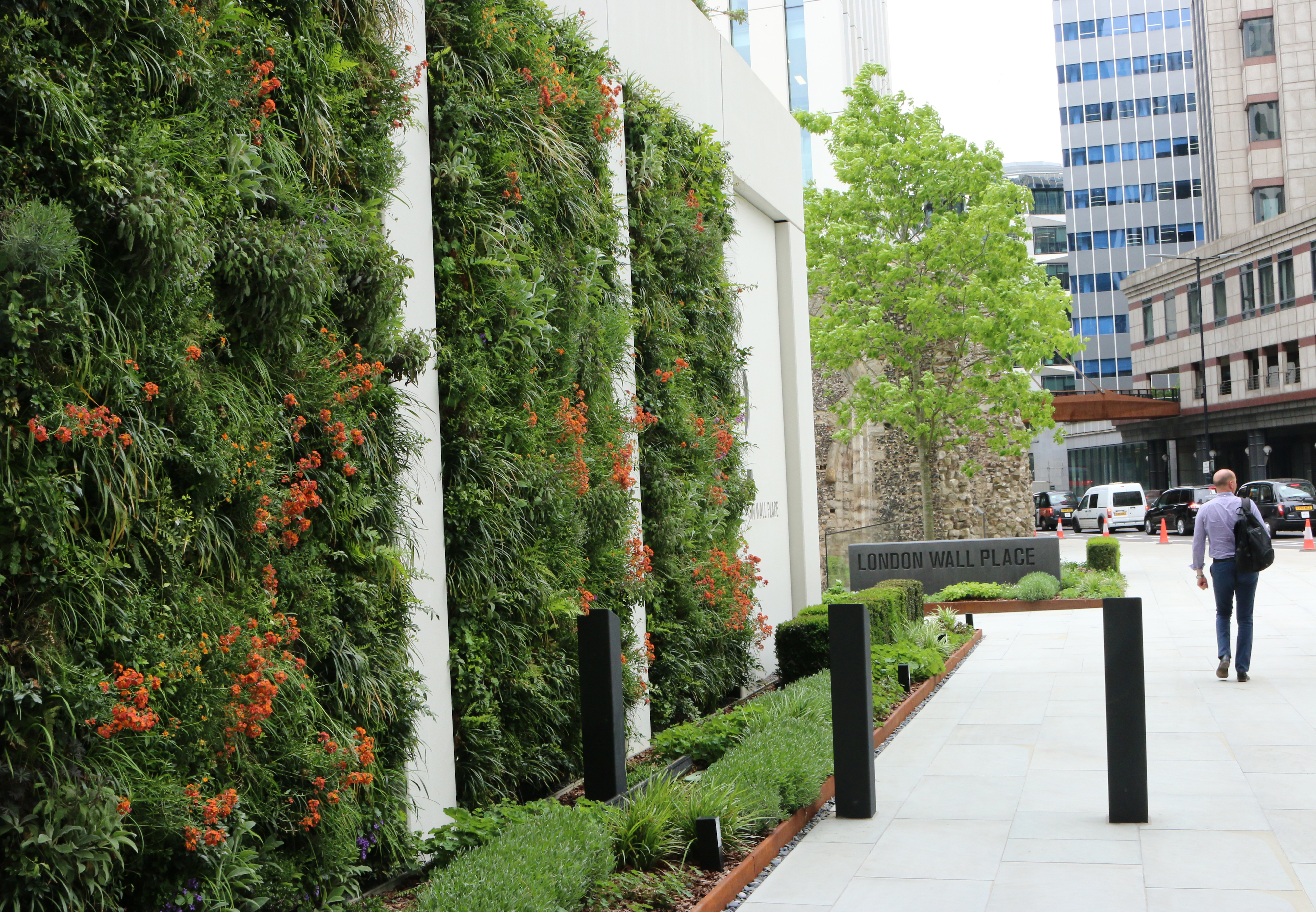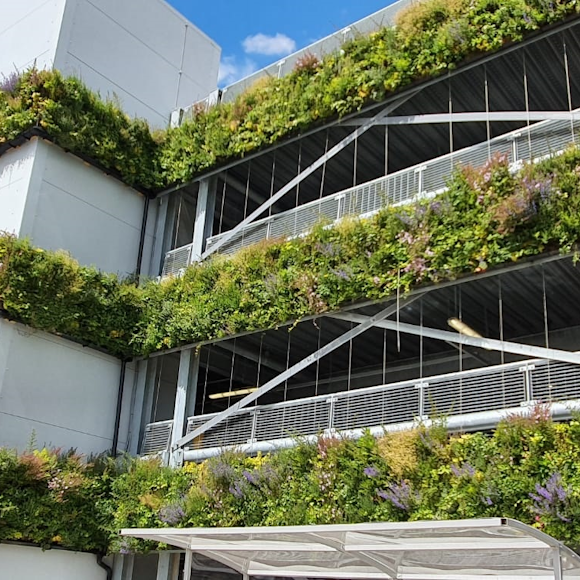Back on 14 June 2017, fire broke out in the kitchen of a fourth floor flat located in North Kensington, London. Within minutes, the fire had spread rapidly around all 4 side of the Grenfell Tower, costing the lives of 72 residents. It quickly became clear that the fire had spread from apartment to apartment via the building’s exterior cladding system.
Although it later became known poor cladding wasn’t the only cause for disaster, the use of combustible materials in construction have been under increased scrutiny ever since – and rightly so.
This also led to the amended Regulation 7(2) which states that “building work shall be carried out so that materials which become part of an external wall, or specified attachment, of a relevant building are of European Classification A2-s1, d0 or Class A1 classified (non-combustible)”.
But what exactly does this classification mean? What do the regulations suggest for living walls? And what else should we be aware of?
If you’re looking to make sense of the fire regulations affecting living walls, and want to know exactly where living walls can be used in accordance with these regulations, continue on. Here, we explore all you need to know about living wall fire regulations.
How living walls are fire safety rated
All cladding and exterior building features are to be tested following the Euroclass standards and using the relevant BS EN 13501-1 fire classification. Following this, a rating will be given to classify the level of combustibility, emissions of smoke, and flaming droplets and particles released.
This is demonstrated in the following format:
Class A1-s1, d0.
The ‘Class A1’ part refers to the classification based on combustibility and is scored from class A down to class C:
- Class A = non combustible
- Class B = limited combustibility
- Class C = medium combustibility
The ‘s’ element refers to the emission of smoke during the first 10 minutes of exposure and is rated from s1 down to s3:
- S1 = little or no smoke
- S2 = quite a lot of smoke
- S3 = substantial smoke
The final factor, ‘d’, refers to the flaming droplets and particles released, and is graded from d0 down to d2:
- D0 = none
- D1 = some
- D2 = quite a lot
So, to put things simply – the lower the rating, the safer the materials are around fire.
But what do these ratings mean in terms of suitable applications then?
Building types, heights, and their relevant boundary (distance from another building) all play a part in which rating they must achieve.
As an example, Assembly and Recreation buildings (including schools and any other buildings classed as B2 or B3 in BS 9999), must achieve a rating of Class B-s3-d2 or better if less than 1000mm from the boundary.
For further information on rating requirements per building types, heights and relevant boundaries, take a look at our living wall fire strategy document here.
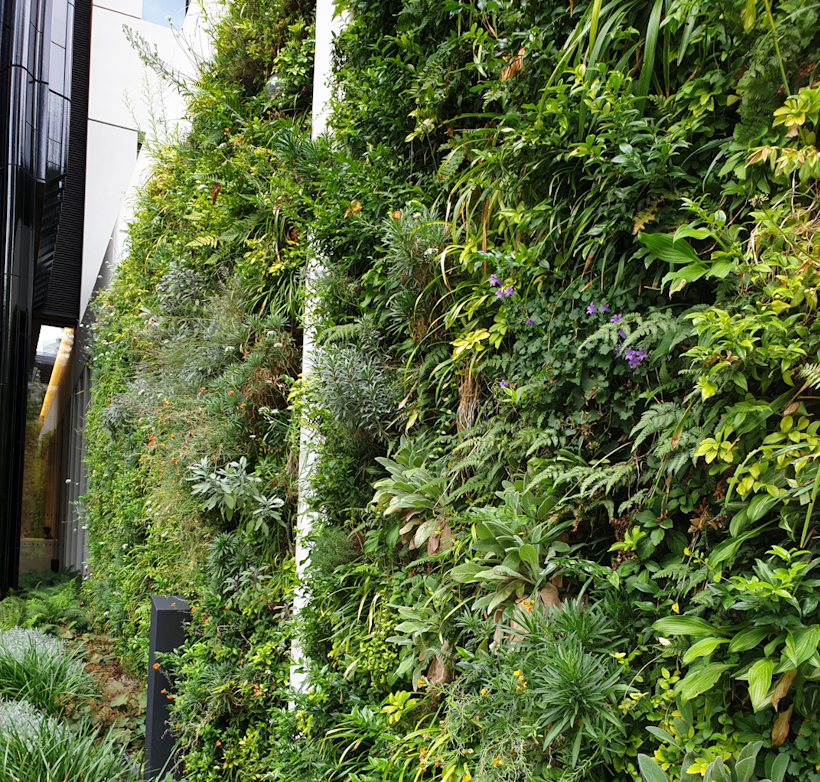
The fire ratings of the Viritopia Living Wall system
At Viritopia, our external living wall system has been designed with fire safety in mind, achieving a Class-B-s2-d0 rating, as tested to BS EN 13501-1.
This confirms our living wall system can be used in accordance with Regulation B4 (external fire spread) for the following circumstances:
- Residential buildings designed to Approved Document B and BS 9991 with a height less than 11m.
- Assembly and Recreation buildings designed to Approved Document B or BS 9999, regardless of distance away from boundary or building height.
- Any non-residential buildings (excluding open-sided car parks) designed to Approved Document B or BS 9999, regardless of distance away from boundary of building height.
- Any healthcare buildings designed to HTM 05-02 regardless of distance away from boundary or building height.
- Domestic and non-domestic buildings with a height less than 11m designed based on the Scottish Technical Handbook, as long as the area is not required to be protected due to the space separation calculations and the elevation is located more than 1000mm from the boundary.
- Houses designed to Scottish Technical Handbook, regardless of distance to the boundary.
Suitable applications for living wall systems
As mentioned, there are various building circumstances that are taken into consideration when deciding on the required performance of a façade.
The building types are broken down into several categories, which include:
Relevant buildings
Defined in Regulation 7(4) as a residential building with a storey height of at least 11m or above, measured from the lowest ground level which contains one or more dwellings, an institution or a room for residential purposes (excluding rooms in a hotel, hostel or boarding house).
For relevant buildings, all materials which become part of an external wall should achieve a minimum of Class A2-s1-d0 other than materials exempted by Regulation 7(3).
So, what does this mean for living walls?
Living walls are considered part of the external wall, thus needs to be considered in residential buildings more than 11m in height. The A2-s1-d0 or greater requirement applies to the whole façade, not just that above the 11m threshold.
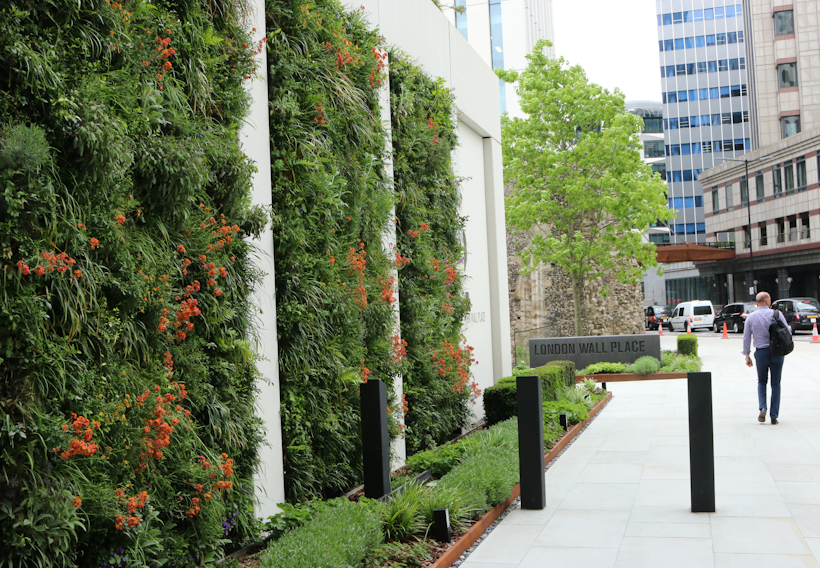
Residential buildings less than 11m high
Residential buildings less than 11m in height aren’t considered a relevant building. Therefore, a rating of A2-s1-d0 like above isn’t required. Instead, further considerations are taken to establish the necessary fire safety rating.
- If the external wall boundary is located less than 1000mm from another building, regardless of height, the surface spread of flame on the external walls should achieve at least Class B-s3-d2.
- For buildings with a storey height of more than 11m and a boundary distance greater than 1000mm, the surface spread of flames ground level to 11m should achieve Class C-s3-d2 or better. However, any external wall above 11m should achieve Class B-s3-d2 or better.
- Buildings below the 11m threshold and boundary distance greater than 1000mm, there is no surface spread of requirements (unless required as part of the external fire spread assessment between buildings).
On this basis, the Viritopia living wall system can be used within accordance of the regulations to improve air quality, boost biodiversity, and enhance the aesthetics of a residential building less than 11m in height.
And the same goes for Assembly and Recreation.
Assembly and Recreation (including schools and retail)
Within BS 9999, the requirements for Assembly and Recreation are considered to apply to buildings with a B2 or B3 risk profile which are more than one storey.
Schools designed under BB100 would also be classed as Assembly and Recreation on the following basis:
- If the external wall is located less than 1000mm from a neighbouring building, regardless of height, the surface spread of flame must achieve Class B-s3-d2 or better.
- Buildings with a storey height of more than 11m and boundary distance greater than 1000mm, the surface spread of flames between ground level to 11m should achieve Class C-s3-d2 or better. Any external wall above the 11m threshold should attain Class B-s3-d2 or better.
- For buildings with a storey height of less than 11m and a boundary distance greater than 1000mm, the surface spread of flames between ground level to 10m should achieve Class C-s3-d2 or better. If the wall is located above a roof or any part of the building which the public have access, the wall up to 10m above these areas should achieve class C-s3-d2 or greater. Any elements of the wall above 10m are not required to achieve a specific rating.
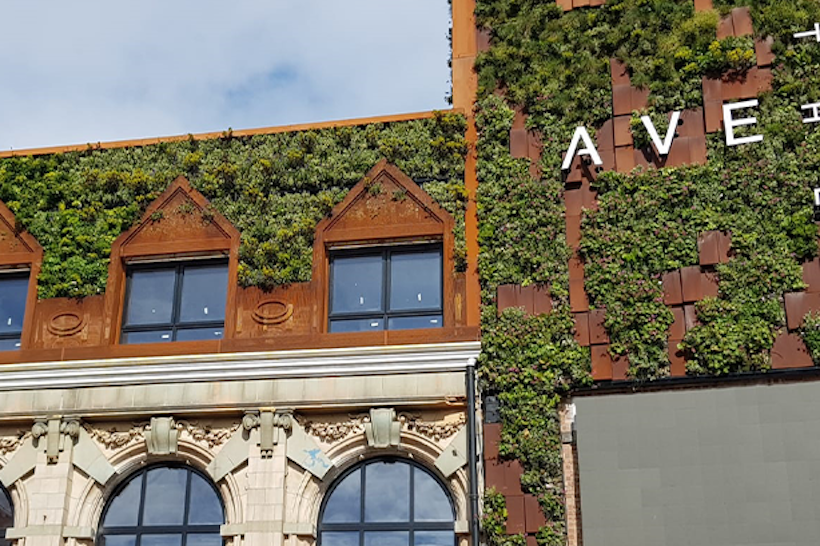
Open-sided car parks
When designing an open-sided car park to Approved Document B or BS 9999, all materials used in the construction should be class A1 rated in accordance with BS EN 13051-1.
Approved Document B Volume 2 allows for the following to be constructed from A1 materials:
- Any surface finish applied to a floor or roof of the car par, if the finish meets the requirements of B2 and B4
- Any fire doorset
- Any attendant’s kiosk not exceeding 15m squared in area
- Any shop mobility facility
Currently, living wall systems do not achieve a Class A1 rating and so cannot be used with open-sided car parks. Why? Live plants are combustible, they’re natural and will never be fire resistant – no matter how well and regularly they’re maintained.
Due to these reasons, it is highly recommended that any living wall system is reviewed in detail before being applied to the façade of the car park. This will require a fire engineered solution provided by a qualified fire engineer to justify the use of a living wall whilst maintaining an open side classification.
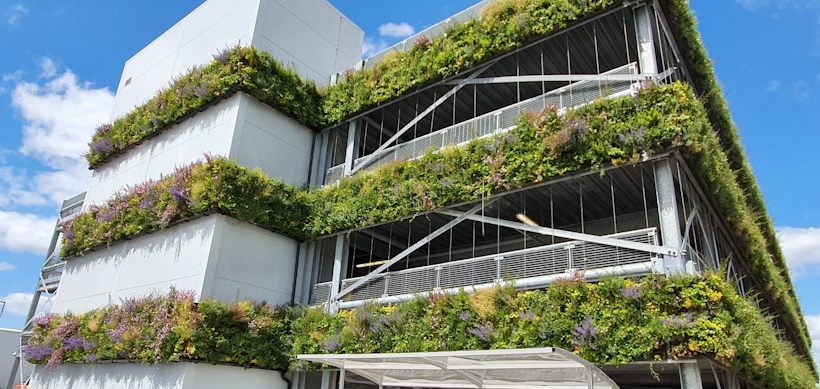
Other buildings
For all other buildings, if the external wall is located less than 1000mm from another building, regardless of height, the surface spread of flame on the external walls surface should achieve Class B-s3-d2 or better.
Buildings with a storey height of more than 11m and a boundary distance greater than 1000mm, the rating between ground level should achieve Class C-s3-d2 or higher. Any wall above 11m should reach at least Class B-s3-d2.
If a buildings’ storey height is lower than 11m and has a boundary distance greater than 1000mm, there is no surface spread of requirements.
Viritopia Living wall applications
So, what can we take from the building types and considerations listed above? To put it simply, our Viritopia living wall system can be used safely and in accordance with regulation for most buildings. However, there are a few exceptions.
Both residential buildings over 11m in height and open-sided car parks require Class A, so cannot be fitted with an Viritopia living wall system.
In fact, it’s impossible for any living wall to achieve Class A. Given the nature of plants, they will always be combustible, no matter which types are used and how moist they are kept, living walls cannot be awarded as Class A.
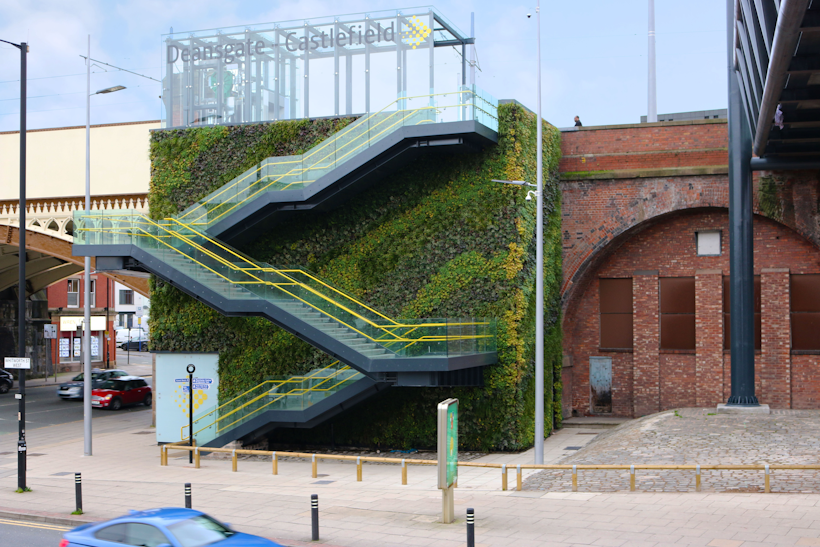
Living wall design – limiting flame spread and combustibility
Although living walls can only achieve a maximum of Class B, it’s super important to minimise the risks of fire spreading and combustibility through plant selection, irrigation and proper maintenance. That’s why for architects, it’s about making sure the company they collaborate with have a proper irrigation system and maintenance programme to work alongside the fire regulations.
Here are the steps we take at Viritopia to limit spread of flame and restrict combustibility of our living walls:
Plant selection
In areas experiencing drought, even moderately flammable plants can become more prone to ignite - this includes both dry and dead leaves.
Selecting plant species that are evergreen, and with limited leaf drop/seeding, limits the presence of dead leaves/heads, thus reducing the chance of combustion.
At design stage, our team at Viritopia select plant species that not only provide a visually appealing living wall, but take into consideration air purification, biodiversity and reduced fire risk.
Irrigation
Keeping plants well-watered is vital for reducing spread of flames and restricting combustibility. This can be achieved through carefully calibrating irrigation to evenly distribute water across the entire living wall.
At Viritopia, we use the latest irrigation technology to maximise the fire safety of our living walls.
Maintenance
Just like a boiler, water tank, and electrical devices, it’s essential to keep on top of the maintenance of a living wall. This ensures the planting remains green and healthy with moist soil, therefore limiting the combustibility of the system.
Prior to installation, we offer a professional maintenance contract to regularly maintain living walls on site. Our team make sure the living wall grows suitably, is pruned accurately and fed appropriately. Once the plants have finished flowering, any dead flowers are removed, and the apical dominance of the plants is kept in check. All of this ensures a healthy, good-looking, and safe living wall for your building.
Tackling living wall fire regulations with Viritopia
Looking for a living wall system in accordance with Regulation B4? Contact our team at Viritopia today. We can design, install and maintain our living wall system which achieves Class B-s2-d0 as tested to BS EN 13501-1 onto most structures. Alternatively, view our living all fire strategy document for further guidance.
